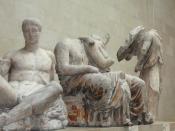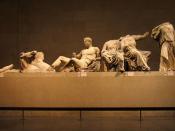Disagreement regarding the ownership of property has caused quarrels among the human race for the better part of its documented history. The concept of ÃÂoursÃÂ and ÃÂsharingÃÂ is really only practiced among small groups of people. Even in small groups, quite often, these ideas are not practiced very well. One major current battle for ownership lies in the world of antiquity. The Parthenon of Athens, Greece, has an enormous amount of history. It has stood since 400 BC as a treasury, a church, a mosque, and above all a symbol of the genius of art and architecture that originated in ancient Greece (Beard, The Parthenon 44). Now in ruins it stands as one of the biggest controversies in the art world. The conflict is between the British Museum and the Greek government. The Greek government has been campaigning against the British Museum since the late 1800s. They are campaigning for the return of the priceless friezes and sculptures that once decorated the interior and exterior of the Parthenon.
These sculptures are commonly referred to as the Elgin marbles. The Greeks are fighting for the return of their history. The Parthenon is the oldest standing structure in Greece. It represents all the great philosophers and inventors of Athens. The Greeks cannot take pride in their culture when it is miles away. Also, the Greek campaign is a step toward returning art to other countries and families that the British Museum has illegally obtained. The British Government has become something of a ÃÂplayground bullyÃÂ in the art world. The time has come for the British Museum to return what belongs to the Greeks and bring an end to its self-seeking actions.
In order to fully understand the situation with the marbles, a short history lesson is necessary. The most obvious...


